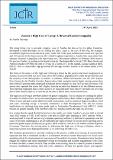| dc.contributor.author | Ng'onga, Aquila | |
| dc.date.accessioned | 2023-05-03T08:27:14Z | |
| dc.date.available | 2023-05-03T08:27:14Z | |
| dc.date.issued | 2023-04-14 | |
| dc.identifier.uri | https://hdl.handle.net/20.500.14274/1784 | |
| dc.description.abstract | The rising living cost is not only a topical issue in Zambia but also across the globe. Countries, developed or least developed are all feeling the pinch. Japan at the start of the year, for example, recorded its highest inflation rate in 41 years. At the end of last year, inflation rates stood at 9.2 percent and 10.5 percent in the Eurozone and the United Kingdom respectively. Zambia like many other Sub-Saharan countries is grappling with high living costs. The annual inflation for February 2023 stood at 9.6 percent. Further, according to the Jesuit Centre for Theological Reflection (JCTR) Basic Needs and Nutrition Basket (BNNB), the cost of living for a family of 5 in the capital, Lusaka stands at KK9, 003.21. This is considerably high given that the average monthly income in the nation stands at K4, 393.00. | en |
| dc.description.sponsorship | Norwegian Church Aid-Danish Church Aid and Scottish Catholic International Aid Fund | en |
| dc.publisher | Jesuit Centre for Theological Reflection | en |
| dc.rights | Attribution-ShareAlike 3.0 United States | * |
| dc.rights.uri | http://creativecommons.org/licenses/by-sa/3.0/us/ | * |
| dc.subject | Cost of Living | en |
| dc.subject | Zambia | en |
| dc.subject | Gender Inequality | en |
| dc.title | Zambia’s High Cost of Living: A Driver of Gender Inequality | en |
| dc.type | Article | en |

